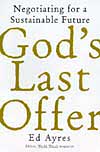
God’s Last Offer:
Negotiating for a
Sustainable Future
by Ed Ayres
Four Walls Eight Windows,
1999, 357 pages
In 1998, S. Sailam, a farmer living with his pregnant wife and two children in the southern Indian state of Andhra Pradesh, found that the pesticide he was spraying on his cotton crop had ceased to do its job. In desperation, he killed himself by squirting the pesticide down his throat. More than 100 of his fellow farmers in the region took their lives with this same tragic gesture in January and February of last year. They had been pressed by the Indian government to abandon their tradition of diversified agriculture in favor of high-tech operations growing monoculture cotton for export, and they needed big yields to pay back the loans that financed their switch. When the farmers’ crops were decimated by caterpillars, their lives were destroyed as well.
Ed Ayres recounts this incident in his new book, God’s Last Offer, in an effort to startle the reader into recognizing the psychological and societal toll of environmental problems. As water sources go dry or succumb to contamination, as topsoil washes away, as climate change provokes more floods and storms and heat waves, how will humans react? Likely with depression, frustration, anger, violence, and, yes, suicide, says Ayres. It’s a deeply troubling component of our present environmental crisis, and one few environmentalists, let alone other members of society, have thought to address.
This is one of the more interesting threads in Ayres’s book, a dense, meaty, and unwaveringly serious rendering of the present state of our environment (which, in case you hadn’t heard, is pretty damn bad). Drawing on the classic style of the Worldwatch Institute, where Ayres works as editor of World Watch magazine, the book is chock-full of hard numbers and stubborn facts. At the same time, it’s more accessible and narrative in style than most Worldwatch publications, and Ayres employs a creative stream of metaphors to illustrate concepts and ideas.
Ayres’s assessment of our environmental situation centers on four “spikes,” or rapidly accelerating trends: the concentration of carbon dioxide in the atmosphere; the number of species extinctions; the level of human material consumption; and the global human population.
Ayres explores how these and other trends intertwine and feed off each other to create webs of ever-more-daunting problems. For example, a burgeoning population pulls increasing amounts of water from an underground aquifer, which begins to deplete rapidly, particularly as climate change causes more hot spells and droughts. Water available for irrigation drops, causing some farmland to be abandoned, and in the mounting heat, remaining farms become more vulnerable to pests, so farmers up their use of pesticides, which make their way into the bodies of both wildlife and humans, potentially affecting their health and reproductive capacities … You get the picture.
God’s Last Offer is a gloomy book in the quintessential environmental style. Still, it’s hard to fault Ayres for writing such a work. Some remarkable progress has been made and more is in the making, but our most serious environmental problems are worsening rather than dissipating.
Ayres holds out some hope, if only the mass of humanity can be shaken from its numbness and convinced to acknowledge and address these issues head on. The biggest problem, according to Ayres, is that the overwhelming bulk of the world populace refuses to see that anything too troubling is coming down the pike. We need to be shaken from our reverie, and quickly, he says. We’re running out of time.


